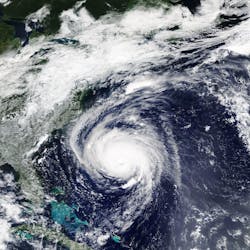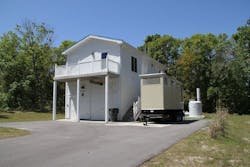About the author:
Mark Moore is wastewater superintendent for the town of Oak Island, N.C. Moore can be reached at [email protected].
Hurricanes are scary occurrences, but not surprising ones in the Carolinas. Statistically, it is expected that one hurricane will hit the Carolina shores every other year. Over the past two years, the state has met its quota.
In Oct. 2016, Hurricane Matthew skirted the coast of North and South Carolina. The storm made landfall briefly at McClellanville, S.C., before tracking northeast back into the Atlantic. Over a two-day period, it brought high winds, heavy rains and a massive storm surge to Oak Island, N.C.
Almost two years later, in Sept. 2018, Hurricane Florence stormed the Carolina coast. It made landfall near Wrightsville Beach, N.C., about 30 miles north of Oak Island. The slow-moving Category 1 hurricane pounded the area with record rainfall of more than 30 in. in a three-day period.
In both instances, there was significant damage, much of it due to flooding. There were fatalities resulting from both events: 39 in North Carolina attributed to Florence and 26 attributed to Hurricane Matthew.
In spite of the massive devastation, public works held up during both storms, especially the states’ sanitary sewers.
Oak Island was prepared for hurricanes and, as a result, its systems weathered the storms. In neither storm did the municipality ever lose electrical power. There also were no sewage overflows during or after the storms. Sewer service was restored throughout the city within hours of the storms’ passing. The utility also kept its public works crews safe as they prepared for the onslaught.
The Big Concerns
Oak Island is located on North Carolina’s Atlantic shore, about 40 miles northeast of Myrtle Beach, S.C. The town is small, with a population of 6,800 in the off-season, but it grows substantially in the summer to approximately 30,000 or more. There are about 3,000 households and about 6,600 housing units in Oak Island.
The town has two sewer systems: a gravity system with 1,000 connections and 32 lift stations, and a vacuum sewer system with 8,700 connections and nine vacuum stations. The gravity system was built in 1992 and the vacuum system was built from 2007 to 2010. Therefore, both are relatively new by public utilities standards.
The biggest concerns for sewer operators facing a hurricane are the loss of electrical power, storm water infiltration and system overflow. The loss of electrical power at vacuum and lift stations means the loss of sewer service in the community. Infiltration, on the other hand, can overload the system and cause backups and overflows that contaminate groundwater and, potentially, potable water supplies. Excess infiltration also can overload the local treatment center.
Losing electric power is not a major concern. The power lines are buried so they are not exposed to the extreme winds caused by hurricanes. Additionally, backup generators are available should the electric grid be shut down for any reason. Oak Island was one of the only towns in the area to maintain power during the most recent hurricanes.
Prior to a storm arriving, Oak Island shuts down its vacuum stations near the beachfront and in low-lying areas. This added benefit of protecting the vacuum system infrastructure is something that is not possible with a gravity system, as there is no way to shut down a gravity system. Doing this with the vacuum sewer is a precaution to prevent storm water or ocean surge from infiltrating and overwhelming the system and damaging the vacuum pumps.
Although vacuum sewers are “closed systems” that prevent both infiltration and exfiltration, storm water sometimes will enter the system from man-made sources. In fact, some homeowners actually have drilled holes in collection line cleanout caps to act as a drain. About 90% of infiltration after a flooding event enters the system this way.
Pre-Storm Actions
- Shutting down the vacuum stations is a simple process that takes five steps:
- Fuel and check the generators;
- Check vacuum cleanout caps to ensure all are intact;
- Pick up around the vacuum stations to prevent flying debris;
- Alert residents that the system will be shut down during the storm; and
- Close specific isolation valves and mark them with a stake (if sand or dirt should wash in and obscure them).
Oak Island waits until the last possible moment before a storm arrives, factoring in a safety margin for staff, to shut down the vacuum stations. Residents who have not evacuated—most seaside residents do evacuate—can still use their toilets and run water on a limited basis, as the vacuum pits and the laterals that connect the house to the pit have some capacity to hold a limited amount of sewage. Once the storm has passed, crews can reopen the isolation valves and vacuum stations within a couple of days.
Gravity lift stations typically remain online during storms, but overflowing the system always is a concern, as collection lines and manholes allow some level of infiltration. During Hurricane Florence, water levels were very close to breaching the lift stations, within a foot or so at some locations, but it never happened. Oak Island was fortunate given the size of the storm surge during that event.
Plan, Learn, Maintain
Hurricane preparedness is a matter of planning, learning from past experiences and ongoing maintenance.
Part of Oak Island’s preparedness lies in the fact that it has vacuum sewers that prevent infiltration and exfiltration. Unless a component is damaged, such as a cleanout cap or valve pit, there is no threat of sewage contaminating the environment or storm water overwhelming the system and the treatment plant.
Past experience—along with advice from the vacuum technology provider, Airvac—has taught city officials and public works employees how to prepare for a hurricane. With a few simple steps, they are ready for the storm, no matter how severe.
The town conducts ongoing rehabilitation and maintenance programs on its gravity sewer collection lines and manholes to help reduce infiltration during storm events. Some storm water inevitably enters the system, but it has managed to keep it at a manageable amount.
The benefits of sewer preparedness are significant. Protection of the environment from sewage, the ability to have full sewer service quickly after a storm, and the safety of staff are all priorities during these events. While the Carolinas can expect hurricanes to come through on a regular basis, it is vital for public works officials to do everything within their control to prepare for storms and keep the sewers functional. The residents depend on this service.


